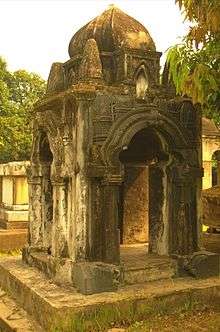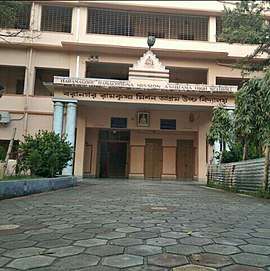South Park Street Cemetery
South Park Street Cemetery is located on Mother Teresa Sarani, Kolkata, India. The road used to be called Park Street, and prior to that Burial Ground Road.
 South Park Street Cemetery, Kolkata | |
| Details | |
|---|---|
| Established | 1767 |
| Location | |
| Country | India |
| Style | The tombs are an admixture of the Gothic with a rich flavour of the Indo-Saracenic style. Of the latter, mention may be made of a unique and composite brick structure built in the ‘panchyatana’ manner, with a central dome flanked by miniature replicas of Orissan ‘rekha deul’ on four sides. Coupled with this peculiarity, the black basalt carvings on the frontal façade indicate a distinct respect for the Hindu faith. |
| Owned by | Private |
| No. of graves | 2000 graves or tombs |
History
The Park Street Cemetery was one of the earliest non-church cemeteries in the world, and probably the largest Christian cemetery outside Europe and America in the 19th century. Opened in 1767 on what was previously a marshy area, the cemetery was in use until about 1830 and is now a heritage site, protected by the Archaeological Survey of India (ASI). The cemetery was opened to relieve the pressure on the old burial ground in the heart of the city. The road leading to the cemetery came to be known as the Burial Ground Road but was subsequently renamed Park Street after the park around Vansittart's garden house. By the year 1785 the burial ground had been extended on the northern side of Park Street and by 1840 a vast new cemetery was opened to the east of the Lower Circular Road. The Europeans started to disuse it in the year 1790. It has been confirmed by a marble plaque at the gate which reads "South Park Street, Opened:1767, Closed:1790".
Tollywood's Bengali film, Gorosthaney Sabdhan (literal translation: Beware in the cemetery) was shot here. The film was based on the novel of the same name by Satyajit Ray.
Notable Tombs

- Rose Aylmer (died 1800)
- Elizabeth Barwell (died 1779)
- George Bogle (1746–1781), diplomat
- Lieutenant-General Sir John Clavering (c.1722-1777), army officer
- Augustus Cleveland (d. 1784), colonial administrator
- Captain Edward Cooke, (1772-1799), Royal Navy officer
- Henry Louis Vivian Derozio (1809–1831), teacher and poet
- Sir Elijah Impey (1732-1809), judge
- Sir William Jones (1746–1794), Indologist, founder of the Asiatic Society
- Colonel Robert Kyd (1746–1793), botanist
- Lieut. Col. Colin Mackenzie (1754–1821), Surveyor General of India
- Sir John Hadley D'Oyly, 6th Baronet (1754–1818), politician
- Major-General Charles Stuart (1758–1828), army officer and Indophile popularly known as "Hindoo Stuart"[1]
- Walter Landor Dickens, son of English novelist Charles Dickens. He was buried initially in Bhowanipore war cemetery and the tombstone was later moved here in 1987
The memorials are almost all architecturally imposing and replete with classical details and sculptures. Among the interesting professions mentioned in the epitaphs are: breeder of cattle, jail-keeper, silversmith, schoolteacher, architect, translator, livery, printer, head tide-waiter, park superintendent, cooper, postmaster and surgeon.[2]
Grave 363 and the oldest
This grave contains only the following epitaph, possibly indicating that the person wished to remain anonymous: "A virtuous mother (died 1825)". The oldest grave in this graveyard is of Mrs.S.Pearson.(1768)[3]
Features
The tombs are a mix of Gothic and the rich flavour of the Indo-Saracenic style. Among the Indo-Saracenic tombs is a unique and composite brick structure built in the ‘panchyatana’ manner, with a central dome flanked by miniature replicas of Orissan ‘rekha deul’ on four sides. Coupled with this peculiarity, the black basalt carvings on the frontal façade indicate a distinct respect for the Hindu faith.
Controversies
A well known business family wanted to turn the cemetery into an arts centre. The demolition work had begun in 1984[4] and the Calcutta High Court intervened and issued an order stopping further construction work. Nevertheless, substantial damage had already been done by then and many graves were lost.
The grave of Charles Stuart was destroyed (and was later restored) and the demolition of Derozio's grave had been initiated, when, Justice Bagbati Banerjee[5] of Calcutta High Court issued orders to stop further construction work.
North Park Street Cemetery
The former North Park Street Cemetery is now the site of the Assembly of God Church School and the Mercy Hospital with only a sole grave standing that recalls its past. The Lower Circular Road cemetery still exists today and is used for burial, although it has fewer monuments.
Gallery
- South Park Street Cemetery Gallery
 The marble plaque which reads: "South Park Street Cemetery, Opened 1767, Closed 1790
The marble plaque which reads: "South Park Street Cemetery, Opened 1767, Closed 1790 The pavilions inside the cemetery
The pavilions inside the cemetery A tomb inside the cemetery
A tomb inside the cemetery The tomb of Charles Hindoo Stuart
The tomb of Charles Hindoo Stuart The tombs inside the cemetery
The tombs inside the cemetery Tomb of Sir Henry Vivian Derozio
Tomb of Sir Henry Vivian Derozio
References
- "Here lies Hindoo Stuart: Inside the 250-year-old Park Street cemetery". The Indian Express. 28 January 2018. Retrieved 23 May 2020.
- Chadha, Ashish (1 November 2006). "Ambivalent Heritage: Between Affect and Ideology in a Colonial Cemetery". Journal of Material Culture. 11 (3): 339–363. doi:10.1177/1359183506068809. ISSN 1359-1835.
- "Here lies Hindoo Stuart: Inside the 250-year-old Park Street cemetery". The Indian Express. 28 January 2018. Retrieved 23 May 2020.
- "Here lies Hindoo Stuart: Inside the 250-year-old Park Street cemetery". The Indian Express. 28 January 2018. Retrieved 23 May 2020.
- "Here lies Hindoo Stuart: Inside the 250-year-old Park Street cemetery". The Indian Express. 28 January 2018. Retrieved 23 May 2020.
- The South Park Street Cemetery, Calcutta, published by the Association for the Preservation of Historical Cemeteries in India, 5th ed. (2009)
- Drost, Alexander, Tod und Erinnerung in der kolonialen Gesellschaft. Koloniale Sepulkralkultur in Bengalen (17.-19. Jahrhundert), Jena: Leander Wissenschaft, 2011. https://www.academia.edu/5444685
External links
| Wikimedia Commons has media related to South Park Street Cemetery. |
- The Telegraph. Sleuth’s trail to cemetery of veiled ghosts, by Rangan Datta. December 26, 2010.
- The Great Cemetery of Asia
